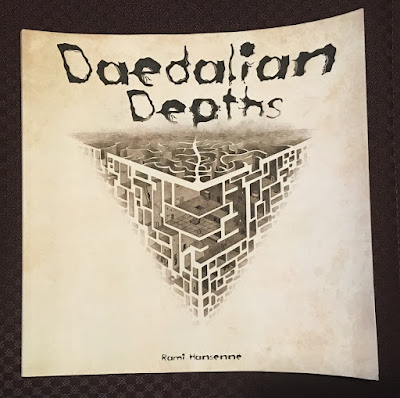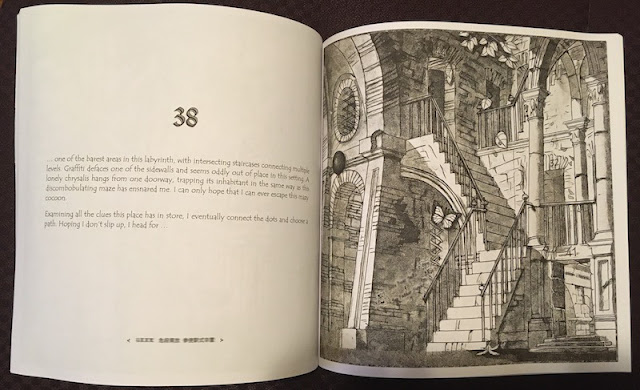Daedalian Depths
Wednesday, June 30, 2021
Comments: 4 (latest August 17)
Tagged: reviews, ruminations, christopher manson, books, praser 12, puzzles, puzzle books, rami hansenne, daedalian depths, maze, mazes
Interested in a puzzle book of classic form? Try Daedalian Depths by Rami Hansenne. A tribute and homage to Christopher Manson's archetypical, unsolvable Maze. But this one is solvable!

(I will avoid puzzle spoilers in this post, but I will repeat some information that the book explains directly in the prologue. I am also going to talk about the puzzle design in very general terms.)
If you remember Maze from 1985, you'll understand DD immediately. You start on page 1. Every page illustrates a Piranesian chamber filled with cryptic, metaphorical objects and signs. Certain doors are numbered. Choose a numbered door to travel to a different page. Watch out for trap pages!
(Yes, I blurred this image just enough to make some of the clues unreadable.)
The prologue lays out the rules:
Journey through the maze until you reach the final chamber. You will know it when you reach it. Here one last challenge awaits you: unlocking the portal to what lies beyond. The means to unlock the gate and escape the labyrinth can be found along the shortest path from the first room to the final gate, following only numbered doors.
You enjoy mapping, right? Course you do!
I found Daedalian Depths very approachable. I solved it in about three days of staring, mapping, and taking notes. That is: I'm sure I have found both the "shortest path" and the "means to unlock the gate". I haven't figured out every single clue on every page, but that's okay! There are multiple clues for each part of the puzzle.
For example, each page has at least two clues indicating the best exit to take. You don't have to understand all of them. But if you do, and they agree, you've got confirmation. Or you can work backwards: figure out how to interpret a clue by knowing which exit is correct. This isn't cheating -- it's more like a crossword, where every square has two clues crossing and you can work from one to the other.
You can also tackle the "shortest path" simply by mapping all the connections and searching. (I remember doing this for Maze as a teenager -- it must have been the first time I implemented a breadth-first graph search. In BASIC!) Of course this will go wrong if you miss a door, so you need to pay attention to the clues to verify your logic. And then there are further clues which will only make sense if you have the path right. Sorry, I'm being vague -- I'm just pointing out that the crossword analogy applies here too. You figure out the clues by following the path, and if you go off the path, the clues don't work, so you back up and look for what you missed. (And indeed this happened to me, and led me to discover an exit that I'd missed.)
Along the way I found some of the "means to unlock", but not all of them. Until I noticed something else, and then a bunch more stuff made sense, and pow! It all came together.
It's worth comparing DD with the original 1985 Maze. Chris Manson's book had a somewhat different challenge:
- Find the shortest path from page 1 to page 45 and then back to page 1.
- Discover the riddle hidden on page 45.
- Solve the riddle, using the phrasing hidden along the shortest path. (Really more like a second riddle, with a final one-word solution.)
Step 1 worked the same as in DD. The exit clues in Maze were muddier and less redundant, but you could solve the maze by mapping. (And some graph search code.)
However, step 2 went off the rails. You were supposed to pick out objects and words, and read them as a sort of rebus. But this was basically impossible. There was so much stuff that you could pick practically anything and make it sound like a riddle-sentence. There were more clues that were supposed to help, but they didn't. And then of course step 3 was even worse, because there's stuff in every room along the way.
(If you want a full explanation of Maze, your best bet is the fan site Into The Abyss. I'd say that site way overanalyzes most of the pages -- too much clue-hunting is just knuckling your eyes in the dark. But the description of the core puzzle is clear, and seems to be more or less what Manson intended.)
Daedalian Depths avoids these flaws by (a) having redundant clues and (b) having consistent patterns of clues. You're not looking for a different thing in every room; you're looking for something that works across all the rooms. When you find it, it works everywhere.
On the other hand, DD lacks a final confirmation step. It doesn't need one -- as I said, I'm sure I found the right answers. I guess I'm a bit spoiled by the Mystery Hunt puzzle tradition. Those puzzles generally go like this:
- Do a bunch of legwork. (Solving crossword clues, figuring out which Harry Potter book a bunch of lines refer to, identifying a list of song clips...)
- Stare at the resulting spreadsheet until a clever insight arrives.
- Do the clever thing with the data.
- An answer comes out. (An English word or phrase.)
(Really, most Mystery Hunt puzzles have several stages, so you repeat steps 2 and 3 several times. And at least one of the "clever insights" is labored and you roll your eyes and say "Yeah, whatever, that part didn't make sense" and by the end your patience is worn out and you just want the flippin' answer. Mystery Hunt puzzles lean to the heavy side.)
It's important that the final answer be a recognizable word; that's your confirmation that you've solved the puzzle right. Ideally, the word is thematically connected to the puzzle, too. If you're solving a puzzle about the B-sides of pop 45 records, and the last stage gives the answer VINYL SIDING, you grin. If what comes out is VYNXL SNADDG, you screwed up somewhere.
(Sometimes the answer has to be a specific word to fit in with the metapuzzle, so you don't get that thematic connection. This can confuse the issue a bit. My Hunt team once came up with the answer COLONEL OX, and we sat around saying, um, is that a thing? Should we know who Colonel Ox is?)
(No, we'd screwed up somewhere. But Colonel Ox is now our team mascot. Moo.)
In this puzzle-writing tradition, you aim for a Clever Insight which flips the puzzle from impossible (cannot be solved even by brute force) to solvable (answer falls out with no need for guessing). This is harder than it sounds!
So let's put Daedalian Depths in these terms. I did indeed hit the moment where the final challenge went from "difficult" (I had only guessed pieces of it) to "solvable" (I knew where every piece was and confidently found the ones I'd missed). But there was no single answer that popped out and confirmed it for me. This feels like a gap, but again, that's just the tradition I'm used to.
In any case, I have solved DD. And nobody solved Maze at all. This puts DD way ahead, design-wise. (The original Maze prize contest ended with no complete winner. The publisher announced the intended solution, and then people got to work reconstructing how it was supposed to be solved.)
What else... I found DD's artwork to be a bit indistinct. It's lovely, but it's a mix of ink drawing and Photoshop ink-style filters. The latter makes textures which can dissolve into swirls when inspected closely -- which you will do lots of. The clues are generally clear, but picking out the clues from the background can require some squinting. (Manson's ink drawings were low-tech, but crisp and clear.) Also, some of Hansenne's detail is really tiny. If your eyes are elderly, you'll want your reading glasses or phone magnifier or Holmes-wannabe lens or whatever you use.
My only other quibble is that the book is written in first person. What's odd is that it starts in the traditional second person:
Now, off you go down the rabbit hole. Though whether to Wonderland or someplace altogether more sinister remains as yet unclear. Let the spectral touch of my authorial hand push you forwards towards...
1. ...a dilapidated room, partially reclaimed by flora. Slowly I awaken from a deep and tenebrous slumber. Somewhat dazed and without recollection of past events, I take in my peculiar surroundings. [...]
And the rest of the book is narrated as "I", not "you". It's an odd switch; I'm not sure it's ever justified. In an interview, the author wrote: "The story in DD is written from a first person perspective so the reader is placed front and center, rather than feeling like an outside observer." (Interview for Mazecast, June 6th.) But isn't that exactly what "you" accomplishes in gamebooks?
(Of course Maze is also written in first person. But that has the conceit of a sardonic and all-knowing narrator, shepherding a bunch of lost guests around his maze. You're not supposed to be him! DD is a straight narration.)
Yes, this is ultimately an artistic decision and I can't really argue with it. But I'm a second-person sort of player, dammit.
None of which detracts from my conclusion: Daedalian Depths is an attractive artifact, a satisfying solve, and a fine heir to the puzzle-book tradition.
I can't leave off without mentioning my own Maze homage: Praser 12. (Don't ask about the first eleven.)
This is an all-text puzzle which I wrote in 2008. I followed the writing style of Maze, but it's rather a different sort of challenge. It's more in the Mystery Hunt style; there's a final answer, an English phrase which (as the introduction implies) tells you where the treasure is hidden.
In retrospect, it's a little underclued and relies on awareness of some Hunt conventions. But people have solved it. Feel free to give it a try.


